
Building a pair of Adire HE12.1 Speakers

Inevitably, as you build single-ended tube amps, you end up wishing for more efficient speakers. The vast majority of commercial speakers out there are designed for amplifiers with gobs of current drive, that is just the way the market went when transistor amps became the norm. There are a few problems with this approach - but then most commercial speakers are used with inexpensive amps and CD players and will never sound that great anyway.
For efficient speakers, you have a more alternatives than one would think:
- Vintage speakers like the Klipsch line (LaScala, Cornwall, Heresy), and old movie theater horns.
- Kits such as the Adire HE10.1 and HE12.1, Bottlehead Straight 8, Oris, Hammer Dynamics, Xtreme Audio, Pi Speakers, etc.
- Oddball commercial speakers like the Cain&Cain, Zu, Avante Garde, Beauhorn, Blue Cow, Classic Audio Reproductions, Edgarhorn, Kochel, Omega, Tannoy, Zingali; a good list of candidates at Welborne Labs.
In this page:
- Adire Links
- Construction Pictures
- Cabinet Design Changes
- Interior Bracing and Lining
- Adire HE12.1 Mk II - October 2004
- November 2004
- December 2004
- January 2005
- Evaluation: May 2005
- Happy Trails!
Over the past few years I've had a chance to hear several systems with good efficient speakers, and they make a huge difference with all sorts of amps. One of the best ways to hear a lot of these systems besides finding a local Bottlehead group is to attend a DIY conference such as VSAC, the Mid-west Horn Festival, or the Rocky Mountain AudioFest.
You'll meet a lot of surprisingly cool tube audio folks and be able to listen to a variety of speakers, amps, turntables, etc. Where else could you hear Oris horns, Azura horns, and Edgarhorns all within a 60 second walk from each other? Highly recommended.
After listening and reading a lot I narrowed my list of possible DIY speakers to the Adire HE10.1, the Bottlehead Straight 8, and the Pi Speakers Theater Four. Of these I had fondest memories of the sound of the Adire HE10.1 at VSAC2001. Then I found out about the Adire HE12.1, and while I could not hear them myself, the opinions I did find mostly agreed that the HE12.1 did everything that the HE10.1 did, but a little bit better, and with a bit milder impedance swing.
Here is the post that pushed me over the edge, from GM, a very experienced speaker designer/builder (this post was not directed at me!)...
Originally posted by GM on diyaudio.com
Now that you've settled on a perfectly good compromise driver/system that may satisfy
long term with enough $$/tweaking, but blows the budget big time, I'm going to suggest what
I would have from the beginning had your initially stated goals been a bit more flexible.
The Adire HE12.1 monitor driver is IMO the current ideal entry level 'horn' driver WRT
cost/performance ratio, with their HE10.1 the runner-up. If they decide to do a HE15.1 these will
probably shift down a notch if other manufacturers don't jump on this particular bandwagon
and one-up them. One can only wish.....
A pair only cost a fraction of a single good condition Altec duplex of any flavor,
has a wider dynamic range/'slam factor' over a wider BW, better phase alignment between the LF/HF,
better mids/HF polar response, and fits in a smaller cab for a given LF output than the Altecs.
With its flatter impedance, it's more tube amp friendly. You can tweak them without worrying
too much over the cost of having to repair/replace one since a proper re-cone of the Altec
costs more, as does their HF diaphragms.
The trade-offs are that you have to tweak them a bit more than the Altecs,
their lower mids polar response isn't quite as 'tight' due to being a smaller driver,
and to some it won't ever sound quite as 'tight' in the upper portion of the LF's BW due to diaphragm/VC construction.
Still, everyone I've talked to that's made the switch from the mid-to-lower high end status quo
are letting them collect dust as they continue to be mesermized by a fairly low distortion/wide
dynamic range coincident speaker, and with only a couple of exceptions these haven't been tweaked
yet nor are any of them in what I would deem optimum cabs.
Or you can take everything down a notch and start with the HE10.1s which have a strong
following also, especially among the currently impecunious WRT disposable income and/or listening room real estate.
GM
Adire Links
diycable.com - Where I bought my kits, Kevin Haskins is a fine human being
adireaudio.com - More information on Adire speakers and their design philosophy

So, how big are they? The pair I built are each 51 inches high x 15-3/4 inches wide x 16-1/2 inches deep. That's pretty big compared to almost any modern speaker, but compact compared to most horn systems.
By the way, I'd like to add a new acronym for Wife Support Factor, or WSF. It's not exactly WAF (Wife Approval Factor). Blithe Hoffman, my partner, has been extremely generous with my 'little hobby', letting me take over the living room for a listening room, and smiling through an unending stream of equipment changes, oscilloscopes in the living room for weeks, speakers in rows blocking the fireplace, and unattended play of the same five CDs for days while I break in new parts. Basically, she's been a goddess, and I'd like to state 'for the record' that she must have one of the highest WSF ratings ever! (Are you reading this, Blithe? Thanks!)
Construction Pictures
Front Baffles front and back shown - doubled up 3/4 inch hardwood plywood with hidden sand dampening channels, flared 4 inch port, threaded mounting inserts, and tweaked Eminence Beta 12CX driver with coaxial Adire 1 inch phenolic tweeter driver. Baffle surface is covered with genuine nauga in a tasteful pigskin emulation. Baffle is joined to speaker body with threaded inserts and silicone sealant, but can be removed if necessary for future modifications.
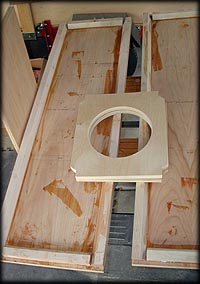


This is almost every clamp I own. Flats with corner braces epoxied in place, note that braces
do not meet at corners.
Of course, I couldn't resist posting while they were still under construction. Urk.
In Reply to: Re: Eminence Beta CX's - network? posted by freddyi on May 02, 2004 at 10:16:51:
...the tweeter driver looks like a modified APT50 - one external clue is the three small
wads of silvery foam inserted equidistant around the phase plug inside the throat.
Adire claims to lower the Fs with their mods so that you can run the phenolic driver with a 1600Hz cutoff.
I've been building a pair of the BR HE12.1s for the past month
(man, this is taking longer than I thought...) and I'm looks like I'm ready to bolt everything together
tonite, though that means I'm probably 2 or 3 days away.
I'll be running external crossovers for a while to try out different caps and resistors, and the
cabinets are very overbuilt compared to the plans (cherry veneer 3/4 in. plywood with beveled maple corner braces,
boatbuilder epoxy assembly, also diagonal braces, roundovers for holes in shelf braces,
flared ports, etc. Cabinet volume was increased to accommodate extra bracing) so I'm hoping to
get good sound after all of this work.
I hooked up the drivers a couple of weeks into the cabinet construction with the external crossovers to run them in a
bit before assembly. Even without cabinets they are a musical driver combo.
Beta 12CX units are modified as follows - removed dustcap and treated area behind cap lip with
Dammar varnish (mostly to improve the look of the leftover ring of dustcap material), also glued
small ribs of maple to the outside of the motor legs and composite foam/felt carpet pad to
underside of motor legs.
Magnet has a removable belt of rubber around the circumference for appearance? Need to glue that down -
seems a little loose on there. Still plan to apply some mortite to the tweeter driver and back of the 12CX magnet...
/pRC
Cabinet Design Changes
I haven't done an update of my website in a while, so I have other pages to edit instead of spending a lot of time pretending to be eloquent here - but these speakers completely trash my old JMlabs Dalines in any A/B comparison. Everyone can easily hear the difference in clarity and spaciousness, and the Adire design is also very involving. Despite preliminary run-in of drivers and crossovers bass was still opening up as the speakers were played daily.
I did not build my versions exactly stock. Oh well. Here is the link to download the assembly manual from Adire:
HE12-1Plans.pdf
[Dang. The original manual has been replaced with the Mk.II manual at the link above. This may cause some confusion
with my crossover notes below since they are pretty different in the updated design.
Sorry about that, I've added some notes on the Mk.II version at the bottom of this page.]
Note that the Adire designs show two different enclosures; a smaller sealed box (acoustic suspension design) and the larger bass reflex design that I constructed.
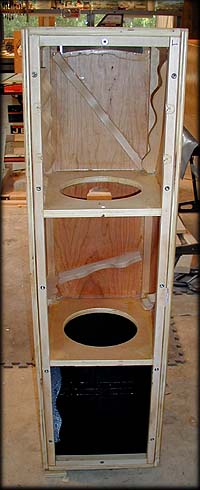
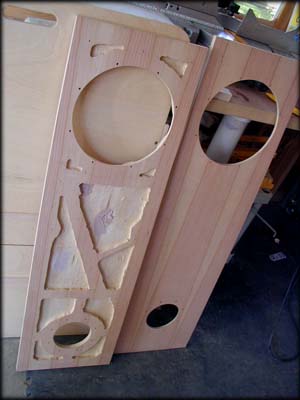
Non-stock Cabinet Construction
- cherry veneer 3/4 in. plywood (two whole sheets required)
- beveled maple corner braces
- boatbuilder epoxy assembly
- wavy beveled diagonal braces a la Terry Cain
- roundovers for holes in shelf braces
- interior joints double-sealed with GE clear silicone caulk
- exterior corners fitted with solid cherry strips to conceal plywood edges
- 4 inch flared ports from Precision Port, per Adire glued up with no center section, equivalent to 4 in straight port
- double thick baffle with hidden sand channels milled into back panel
- baffle is attached with 13 1/4-20 fasteners into theaded inserts in the maple bracing
- baffle is sealed with silicone caulk - sortof removeable in case of future mods.
- cabinet volume increased to accommodate extra bracing
- composite foam/felt carpet pad on 3 walls
- 1/2 in felt carpet pad over composite pad at strategic points
- 1/2 in sheet of polyester batting stapled across lower brace opening
- 12 ounces of Acousta-stuff teezed into middle and upper sections
- all plywood and maple finished with danish oil
- lower section of cabinet interior painted with sand/latex enamel - black

Driver Modifications
- Removed dustcap and treated area behind cap lip with Dammar varnish (mostly to improve the look of the leftover ring of dustcap material)
- Glued small ribs of maple to the outside of the motor legs with Goop brand Marine Contact Adhesive
- Glued composite foam/felt carpet pad to underside of motor legs
- Magnet has a removable belt of rubber around the circumference for appearance? Need to glue that down - seems a little loose on there
- Still plan to apply some modeling clay to the tweeter driver and back of the 12CX magnet


Crossover Modifications
- external crossovers with euro-style terminal strips for testing parts
- Replace cement power resistors with 12W Mills WW resistors
- Replace 2.4uF Clarity cap with 2.2uF Mundorf Supreme bypassed with .22 Western Electric PIO
- Replace 4.7uF Clarity cap with 4.7uF Mundorf Supreme
- Replace 22uF bipolar electrolytic cap with 22uF Solen
- Replace 12uF Clarity cap with?
- Replace 2.7mH Solen inductor with 16ga copper foil inductor
More Crossover Modifications, September 2004
- Replace 4.7uF Mundorf Supreme with 4.7uF aluminum foil/oil cap (Welborne Labs)
- Replace 22uF Solen with 20uF VDC vintage C-D oil caps + 2uF GE motor run cap
- Replace 12uF Clarity cap with 5uF vintage Sprague oil caps + 7uF Aerovox motor run cap
Note: BIG difference in bass response with the vintage caps, much more lively and listenable in my system.
Alternate Crossover parts
low-pass on 12CX -
1st order 1000Hz - 1.0828mH
1st order 1200Hz - 0.9023mH
1st order 1400Hz - 0.7734mH
1st order 1600Hz - 0.6767mH
1st order 1800Hz - 0.6015mH
high-pass on tweeter driver -
1st order 1900Hz - 10.4uF
1st order 2000Hz - 9.93uF
1st order 2200Hz - 9.03uF
1st order 2400Hz - 8.28uF
1st order 2600Hz - 7.64uF
1st order 2800Hz - 7.09uF
tweeter attenuation - APT50 is 105dB/meter at 8 ohms
R1 R2
105 - 94 = 11dB - 5.75 3.14
105 - 95 = 10dB - 5.47 3.69
105 - 96 = 9dB - 5.16 4.39
105 - 97 = 8dB - 4.81 5.29
R1
-----------------VVVVVV-----+----|
| |
> |
> SPKR
R2 > |
> |
| |
----------------------------+----|
Interior Cabinet Bracing and Lining
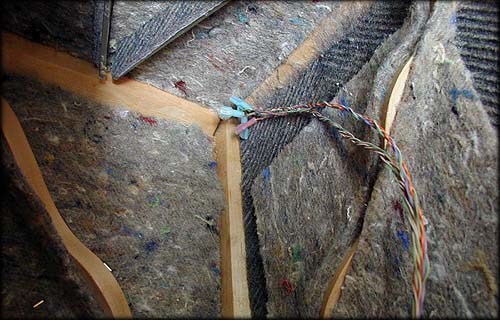
Interior lining with carpet padding, glued to plywood.
Diagonal braces are maple with curved bevels - an idea from Terry Cain - thanks!
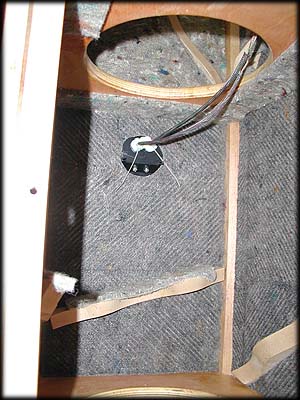
Top image shows upper chamber looking up - hard to see the aluminum L braces for top panel. The interface between metal and wood provides good dampening of resonances. CAT5 cable is used to connect with external crossover - clips are temporary until crossover components are settled, then final design will be soldered in place.
Right image shows middle chamber looking back at binding post cup. The diagonal braces are low in this section so that I could go back and convert the cabinet to the acoustic suspension variant - Adire specs the sealed cabinet as half the size of the bass reflex version.
What did I learn from all of this?
- According to an article in Speakerbuilder magazine, hardwood bracing and epoxy glue sounds better
- Many sources report that flared ports work much better than traditional straight ports
- Not joining braces at corners gives you multiple smaller resonance modes that break up faster; joining braces locks the panels into a single large resonance mode - Thank you GM
- Cutting diagonal braces with wavy bevels is easy on a bandsaw, and they look cool too - Thank you Terry Cain
- It takes longer to build speakers than I thought
- You can NEVER have too many clamps
- Be careful with fingerprints on the veneer when you are using any sort of glue
- Vinyl or leather covering can hide mis-drilled holes in your baffle
- Big speakers are heavy, there is just no way around that
- During break-in, don't panic - keep waiting and the sound will change
- Furniture Wax! It's not finished until you wax the surface carefully
The Adire HE12.1 Mk II - October 2004
After some months of hints by Adire's Dan Wiggins on various boards that an updated crossover was in the works for the HE12, the new kit was released sometime in August. I've looked over the materials online - HE12-1Plans.pdf - oops, they updated the PDF and the original version is now a mystery to those who follow later! I apologize for any confusion I may cause, since most of this page is based on the earlier design.
Here is the poop on the update. The cabinet designs are unchanged, but the old phenolic high-frequency compression driver is replaced with a new titanium dome unit. This required multiple changes, really an overhaul of the crossover design. While there are a few common components between the original and Mk.II crossovers, the wiring is totally different. The result, according to Adire and from the frequency response curves in the PDF, is a much smoother response with greater high-frequency extension.
The tweeter crossover is much simplified and looks more direct electrically, the woofer Zobel (an impedance correction) has beefed-up capacitance. Urk. I've spoken with Adire, and there is a pair of the new drivers on it's way so I can try out the new design in my cabinets, but the values are different enough that I will try to build a second set of crossovers so that I can swap the drivers and Xovers without too much doinking around. Aural memory is fickle and I'm afraid this may take several passes back and forth to understand the real differences in the system.
Briefly, here is a rundown on the new crossover.
Woofer Zobel
- Original - 0.30mH inductor + 22uF electrolytic cap + 13 ohm wirewound resistor in series
- Mk.II - 10 ohm resitor + 0.24mH inductor + 275uF electrolytic capacitor in series
Note: the high capacitance will make it very difficult to swap the electrolytics for film or foil caps. Also, the Zobel was in parallel with both the woofer and tweeter in the earlier design.
Woofer LP Crossover
- Original - 2.7mH inductor in series with driver + 12uF cap in parallel with driver terminals
- Mk.II - 2 LRC layers -
First a 1.3mH inductor in series + 7.5 ohm and 10uF cap in parallel
Second a 5.1mH inductor in series + 8.2uF cap in parallel
Tweeter HP Crossover
- Original - very complex! 2 series caps, 2.4uF and 4.7uF with 2 inductors in parallel, 0.36mH and 0.56mH. Also a resitor and cap in parallel before the driver connection, 20 ohm and 0.18mH.
- Mk.II - much simpler. A series 2.7uF cap, an 0.30mH inductor in parallel with the driver, and another series 9.1uF capacitor
Note: the 9.1uF cap presents some difficulty in replacement in oil caps, will need to parallel values.
I will ask Adire if it is OK to post the original crossover here for clarity.
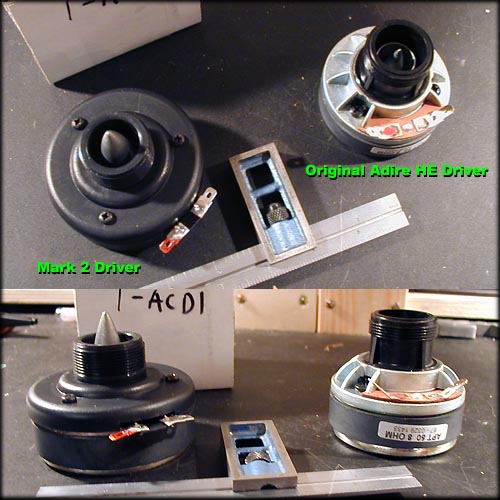
On arrival the new tweeter compression drivers don't look like much - a dead ringer for a $20 CTS titanium driver at PartsExpress. The black plastic faceplate/mounting makes a tinny 'clack' when you tap it with a fingernail. I removed the faceplate and filled the gaps between the ribs with modelling clay, and also stuck a disk of mineral-loaded car sound deadening on the back of the magnet - this reduced the resonance quite a bit.
More later...
Update: November 2004
After listening to the Mark II tweeter and crossover for several weeks, Steve Killian and I drove up to Pennsylvania for the weekend for the 2003 Oswalds Mill Tasting festival in mid-November. I took il Monstro and a re-housed lead-acid-battery-powered Sonic Impact digital amplifier (talk about contrasting DIY philosophies!) for show and tell, but we never got the chip-amp into the system.
Jonathan Weiss, the host, has an incredible system in the huge main room up there based on vintage RCA theater horn technologies - bass horns, segmented mid-horns with RCA 1428 field-coil drivers, and conical treble horns also with field-coil drivers. Astounding detail and presence with these speakers, even in a huge room with 30 inch thick stone walls. Alternate speakers used that weekend included other RCA theater horns and also a mismatched pair of 6 inch (?) field-coil radiators.
So I was able to hear il Monstro with a truly state of the art (!) high-efficiency speaker system and it was a mind-warping, expectation-altering experience. On returning home I found the Adire Mark II setup unlistenable - muddy in the midrange transition area and some odd integration issues.
In a fit of upgrade-itis I ordered a pair of Selenium 12CO1P 12 inch coax drivers and installed them the evening they arrived. I had been looking at these drivers in the Parts Express catalog for a while. The Selenium drivers drop right in with the same mounting dimensions as the Eminence Beta 12CX, and look and feel like better quality versions.
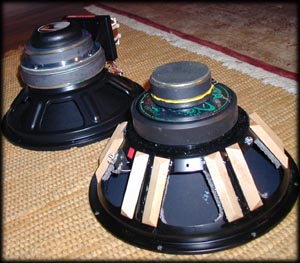
The magnets are heavier, the flux density across the woofer gap is 20% higher than the Beta 12CX, and the compression driver is a Selenium D205ti titanium diaphragm with a 51mm voice coil. Between the heavier woofer and driver magnets, the Selenium coax feels like it weighs about double the Adire combination. Efficiency is listed at 1 dB better than the Beta 12CX.
The Selenium-supplied crossover is much simpler than the Adire design - Woofer has a first order low-pass with a 1.1mH inductor; low-pass rolloff starts at 1100Hz and compensates for a rising response in the midrange of the 12 inch driver. Tweeter compression driver has a 1uF cap in parallel with a 10 ohm resistor; probably a compensation to cut the D205ti output to match the woofer and to extend the high-end response. Then a second order high-pass crossover with a 4.7uF cap and .3mH inductor - I calculate the high-pass rolloff at around 2100Hz.
The crossover uses air-core inductors and polyester (Mylar) capacitors, and is bolted to the assembly. Wires run to the speaker driver terminals with detachable spades for the woofer and spring terminals at the compression driver, so the unit can be easily removed for an external crossover upgrade.
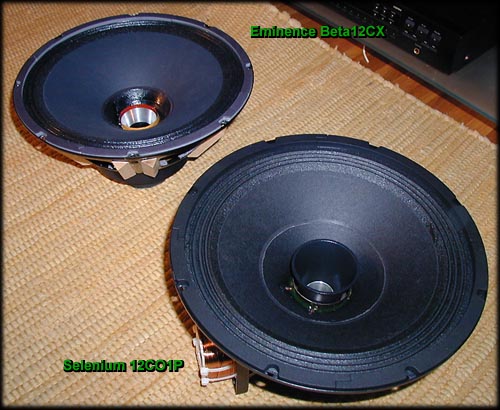
From the front with the dustcaps removed you can see more differences: The multiple rolls of the woofer surround are more compliant with the Selenium driver. The heavy rubber trim on the frame edges is thicker than the cardboard on the Eminence driver. The aluminum high-frequency horn extends forward of the woofer cone and is longer than the Eminence version, v. the Eminence with a rather nasty mouth termination - sharp edges and the woofer's Kapton voice coil former extending past the horn edges have to cause some edge diffraction and distortion. The Selenium horn has a smoother radiused edge, but the woofer has some odd possibly resonant hollow ring shapes between the voice coil former and the sides of the tweeter horn.
So, let's see how they sound - hrm, good for raw drivers with a built-in crossovers. After a day or so, they sound much better. A bit more efficient than the original drivers too - seem louder at the same preamp volume position anyway. A little loss of clarity on some vocals - maybe some edge effects caused by the coax horn?
Now to try some mods:
- Dampening the woofer basket
- Apply some stick-on felt to the back of the tweeter horn and listen for changes
- Remove the stock crossover and build an external one with boutique parts
- Maybe try one of the BMS ring compression drivers per Bill Wood's conversation at Oswalds Mill?
- Paint the center horns gold? Gold leaf? They need something!
If this doesn't work out, my next stop up the driver ladder is a PHL 4070 12 inch coax ($340/ea, yikes).
Again, more later...
Update: December 2004
I've been exchanging eMails with the PHL distributor and he says that the PHLs have the same sort of horn-to-woofer transition problems...
I had a brainstorm on both the Eminence and Selenium drivers. For the Eminence woofer I got out a razor blade and spent 45 minutes trimming the Kapton voice coil former back so that it no longer extended in front of the horn mouth - I still need to apply some filler to the transition and there are two spots that stick up where the voice coil wires were looped over the former, but this should improve things. Need to listen and find out.
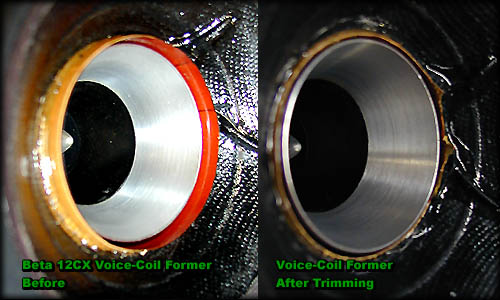
Hrm, looking at that glue joint between the cone and the Kapton voice-coil former, I think I may need to add a ring of paper to smooth out the transition and make the area look more presentable...
For the Selenium I've been thinking that it may be possible to remove the front section of the tweeter horn (press-fit? threaded? glue?) - If I can get that thing off then I could build up the outside with Bondo or something to fill the serious gap (1 cm?) between the horn and the woofer voice coil. Alternatively, maybe I could make a replacement horn from turned wood and get a shorter, more flush fit... Still thinking on this.
Again, more later...
Update: January 2005
Well, after giving the Selenium drivers a fair break-in and using them for two months, I started to process of comparing them to the original equipment Adire-spec drivers.
It isn't even close.
The Selenium drivers have more bass but are, well, clouded in the mids. I had recognized this before, and even stuck felt to the outside of the central horn to alleviate some of this confused sound, but playing mono on one speaker v. the other it is obvious that this Selenium driver design has something seriously wrong with it; and the Eminence units sound better than I remembered.
A shame really, since they are impressively heavy and look like they would be tough as nails. My apologies if anyone followed me down this blind hole - maybe I can sell these to a local band for PA use?
I have also ordered some other 1 inch compression drivers to evaluate in the Eminence units and will report on them later...
Evaluation: May 2005
I went back and listened to both of the OEM Adire tweeter setups again - the Mark 1 and Mark 2 (now available) - along with a couple of other 1 inch drivers, and I have come to the conclusion that I am not really happy with any of them...
Part of this is fatigue, but I think it is more due to hearing more speakers and especially horn setups where music just worked better. The nagging feeling in the back of my brain that led me to try the Selenium coax drivers gradually developed into stronger opinions about these speakers (I can't believe I am going to write this and then try to sell them, this is stupid, really dumb - keep in mind that these speakers do sound good, and interpret these issues in comparison to outstanding horn systems)
The Not-so-good:
- Something is wrong with the voice area of the crossover. Even with upgrades to the components and careful construction they still sound 'cloudy' in the midrange and treble.
- While they sound OK at low volumes, they really don't groove until they are cranked a bit. And I don't really enjoy listening at that level all the time.
- They sound better with some types of music than with others - jazz and 80s rock sound good, 60s rock not so good...
The Good:
- They ROCK at volume. Would make outstanding speakers for a jazz club, etc. (large listening room?), with the right amplification.
- They have sometimes startling presence on some instrumental pieces - Clarinet, Trumpet, etc.
The Result:
I bought a pair of the Fostex FE166ES-R 'special edition' drivers from Madisound back in January (2005) and built the Fostex factory design backhorn for them. I was *this* close to buying a pair of 12 inch Tannoy coax drivers on eBay before I bought the Fostex FE166ES-R drivers. Now I'm committed to trying the back-loaded horns for a while. I've always enjoyed Terry Cain's speakers when I've heard them, maybe this is the way to go... no crossover.
I saw in the last Parts Express flyer a new coax driver with neodymium magnets shared between the tweeter and woofer - B&C NCX series, 294-686 $309/ea - might work really well in these cabinets.
Happy Trails!
 Final version of the HE12 speakers, new black vinyl on the baffles.
Last seen in the back of a Volvo wagon headed for a new owner in Charleston, SC! If you see them, give me a shout.
Final version of the HE12 speakers, new black vinyl on the baffles.
Last seen in the back of a Volvo wagon headed for a new owner in Charleston, SC! If you see them, give me a shout.



